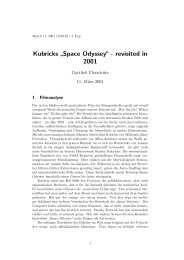Henry M. Taylor, 'Frames, Cons, and Double-Crosses - Cinetext
Henry M. Taylor, 'Frames, Cons, and Double-Crosses - Cinetext
Henry M. Taylor, 'Frames, Cons, and Double-Crosses - Cinetext
Create successful ePaper yourself
Turn your PDF publications into a flip-book with our unique Google optimized e-Paper software.
In HOUSE OF GAMES, the con men give Margaret their confidence, the basis, as we later find<br />
out, of any successful con. So, what has happened is that the situational frame has shifted, it has<br />
been enlarged to reveal that the players are in fact a single group of confidence tricksters <strong>and</strong> that<br />
Margaret's role in the setting was not that of a distanced, uninvolved onlooker on the outside of<br />
the game, but an integral <strong>and</strong> crucial part of a larger game in which she was to be the victim:<br />
from her point of view, the situation involved Mike <strong>and</strong> herself versus the guy from Las Vegas,<br />
with the other players more or less neutral, if sympathetic towards Mike; whereas in truth it was<br />
Mike <strong>and</strong> all the others against her. This constitutes a reversal of her usual position in her profes-<br />
sional work with patients. The situational frame has shifted from what appeared to be an open<br />
game to a closed setting, i.e. the frame has been enlarged to encompass all of those present. The<br />
outside of the micro-game (poker) has been shown to be included in yet another bigger frame, a<br />
macro-game (the con). The narratological basis of this shiftiness of the situational frame is exter-<br />
nal focalization, i.e. a restricted range of knowledge, which in turn is based on restricted commu-<br />
nicativeness, in which the film viewer in this case is placed in the same position as the innocent<br />
protagonist.<br />
To comprehend any game, what is crucial of course is knowing where it begins <strong>and</strong> where it<br />
ends, a clear sense of what is inside the game <strong>and</strong> what is outside. By shifting the frame refer-<br />
ence, however, the narration is deliberately simulating false borders <strong>and</strong> dissimulating the real<br />
ones; <strong>and</strong>, as Margaret will finally realize, the real con is a much larger one, which had already<br />
begun before she went to the ―House of Games,‖ the con game there <strong>and</strong> its subsequent revela-<br />
tion by the tricksters being itself a con in the service of an elaborate overarching plot to relieve<br />
her of 80,000 dollars of her own money, as well as leaving her feeling guilty <strong>and</strong> paranoid about<br />
being responsible for the (fake) murder of a (fake) policeman – as is revealed in the third act, at<br />
the moment of anagnorisis, of both revelation (to the film audience) <strong>and</strong> recognition (by the pro-<br />
tagonist), the greedy businessman, himself apparently double-crossing the con men by appearing<br />
to be a cop in a sting operation, is just another player on Mike's team of crooks.<br />
Games within games within games. The narrative mechanism of enlarging the situational<br />
frame is a variation of what is known in art theory as mise-en-abîme, the play within the play, the<br />
image within the image, <strong>and</strong> of what Luhmann's sociological systems theory (borrowing the term<br />
from George Spencer Brown) calls re-entry. In principle, situational framing can be enlarged to<br />
the point of explicit self-reflexivity, to encompass the whole work. And in HOUSE OF GAMES it<br />
15



